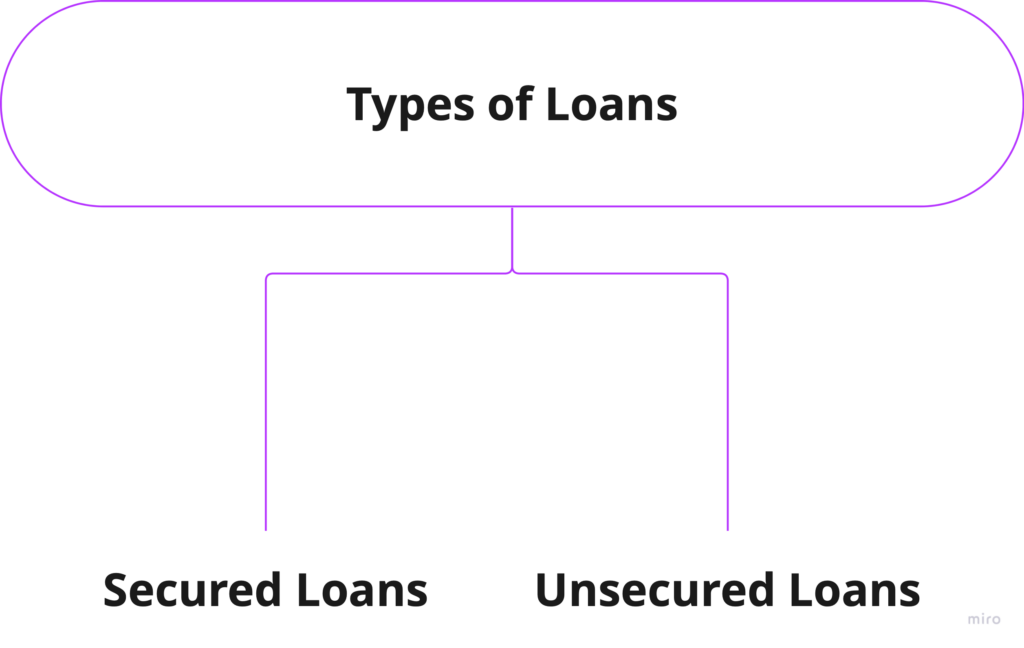A loan is one of the most used terms in finance. However, many people are still unaware of the types of loans that exist and how to apply for them. Not to mention, it can be a tedious job to draw a loan, whether a home loan, car loan or otherwise.
But if you need financial assistance, you can draw a loan. Before we get into the different types of loans, let’s understand what a loan is.
You will Learn About:
What is a loan?

A loan is any type of credit where one party gives money to another party with a promise or obligation of future repayment. The party that gives the money is known as the lender, and the party that borrows it is called the borrower.
While the borrower needs to return the money after a pre-decided period, they also have to pay a charge for the money. This charge is known as interest. The repayments include the amount taken as a loan and the interest charge. The borrower must discuss the interest rate with the lender before borrowing and accepting other terms and conditions. You may use a loan calculator to understand your monthly repayments.
Lenders can be of different types. Mostly, people go to banks for loans and must make repayments as per the schedule. However, you may also contact your friends and family for a loan.
Loan – Main Highlights
- A loan is an obligation of repayment of money from one party to another party.
- For a loan, a bank will check your income and debt levels before approving the application.
- When you take a loan from a financial institution, you must pay the pre-decided instalments, including the principal amount and the interest.
- There are different types of loans, and you must assess your requirements before selecting the type.
Interest on loans
Before you decide to draw a loan, you must be aware of the financial implications that come along with it.
The interest rates impact the final amount you must repay the bank/borrower. The total repayment amount is calculated by adding the principal amount, i.e., the amount of loan you take along with interest charged by the bank. The final amount is then broken down into monthly payments, which you must pay to the bank.
For instance, if you take a loan of Rs. 10,000 for a year, and the bank charges a 10% annual interest rate, your final repayment amount would be Rs. 11,000 (Rs. 10,000 (Principal) + Rs. 1,000 (Interest)).
Now, the interest can be of two types – simple interest and compound Interest. Let’s understand how both are calculated.
For example, if you take a loan of Rs. 3,00,000 from a bank at a 15% simple interest (per year), you will have to pay the bank Rs. 3,45,000 at the end of your loan tenure. Rs. 45,000, i.e., 15% of Rs. 3,00,000, is the amount of simple interest that you need to pay.
However, banks don’t follow this method of charging interest. They follow the concept of compound interest, where you must also pay interest on your interest payments as well.
So, for the first year, the borrower owes an amount equivalent to the principal plus interest. However, for the second year, the amount becomes principal plus the first year’s interest and interest on the total amount.
Let’s take an example to understand it better. Suppose you have borrowed Rs. 3,00,000 at a 10% compound interest. At the end of the first year, the amount due will be Rs. 3,30,000 (Rs. 3,00,000 as principal and Rs. 30,000 as interest).
However, in the 2nd year, the 10% interest will be calculated on the amount at the end of the 1st year, i.e., on Rs. 3,30,000. Hence, the amount due at the end of the 2nd year is Rs. 3,63,000 as Rs. 3,30,000 becomes the new principal, and Rs. 33,000 is the interest.
Types of loans
There are several types of loans out there. Before you choose a type, you must define the purpose of drawing a loan. The purpose could be funding your education, buying a car, buying a house, financing medical expenditures, and more.

Primarily, there are two types of loans:
- Secured Loans
- Unsecured Loans
In the case of secured loans, you need to provide collateral (an asset that you own) as security for the money you borrow. The banks ask for collateral so that they can sell it and redeem the loan amount if you fail to make the monthly repayments on time.
For unsecured loans, the bank does not ask for any collateral but charges a higher interest rate instead.
Types of secured loans
Some popular types of secured loans include:
- Home loan
- Loan against property
- Loans against an insurance policy
- Gold loans
- Loans against FDs
- Loans against mutual funds
In all these loans, you must provide collateral to the bank. The kind of collateral can be mutually decided between the borrower and the bank.
Types of unsecured loans
The most common unsecured loans include:
- Personal loan
- Short-term business loan
- Flexi loans
- Education loan
- Vehicle loan
You can decide the type of unsecured loan you want, depending on the purpose of borrowing money.
Repayment of loans
Loan repayment refers to the process of returning the money that you borrowed from a lender. If you take a loan from any bank, they will provide you with a loan repayment schedule. You are required to stick to the schedule and pay equal monthly installments or Equated Monthly Installments (EMIs).
Different banks, lenders and NBFCs follow different repayment criteria and procedures. Also, loans drawn through personal relationships like family and friends may have a flexible repayment option.
Conclusion
Loans come to your rescue when you are in financial trouble. They are a vital part of the economy as the lenders help the borrowers and are compensated for the risk, which keeps the economy moving. You can get in touch with a bank if you want a loan. However, to ease the process, ensure a healthy debt score. A bank advisor will help you out with the entire process.
FAQs
Did you Like the Explanation?
Authored By:
I'm a Senior Content Writer at Tickertape. With over 5 years of experience in the financial industry and insatiable curiosity, I bring complex financial topics to life in a way anyone can understand. My passion for educating others shines through in my approachable writing style.
Aastik Chhabra



